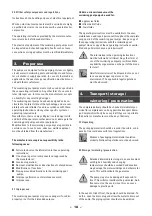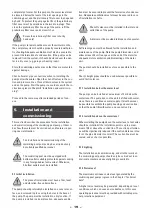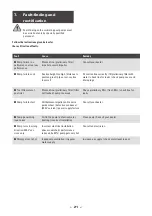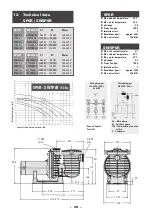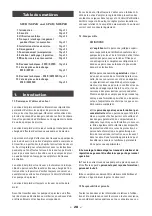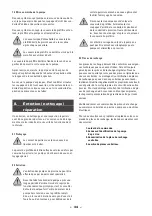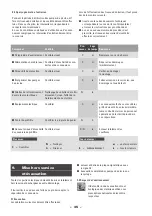
5.2 Connecting the pipes
Care must be taken to ensure that no leaks occur
following installation of the connections.
If the inlet and outlet pipes are connected direct
to the pump, only Teflon seals must be used.
Hemp or other sealing materials must not be
used.
If screw fittings are used, these must not be
sealed by sealing compounds. The screw fittings
seal with the aid of an O-ring, and need only be
tightened hand-tight.
The pump inlet and outlet thread connections are
equipped with a thread stop. The thread
connection fitting must only be screwed on as
far as the thread stop.
The piping installation should be started at the pump, in or-
der to avoid stresses to the pump housing. The suction and
pressure lines should be attached separately to the pump
as firmly as possible to minimise stress in the piping. Air po-
ckets can be avoided by installing the suction line at a slight
incline toward the pump. A straight pipe of at least 50 cm in
length should be installed to the suction connection.
5.3 Electrical connection of the swimming pool pumps
The electrical connection must be carried
only by a qualified electrician!
A separator must be installed in the
electrical system which allows
disconnection from the power supply with
a contact opening gap for each pole of at least 3 mm. For
pumps with 400 V 3-phase motors, a properly adjusted mo-
tor protection switch must be installed. Since this does not
permanently disconnect the power supply of the motor in
the event of operating problems, an additional motor pro-
tection switch should be installed. The manufacturer ac-
cepts no liability for damage to the motor that can be pre-
vented by the installation of an external motor protection
switch. Please note the motor specifications given on the
motor rating plate. Otherwise, all guarantee claims are inva-
lidated in the event of damage to the motor. Automatic mo-
tor overload protection is provided for AC motors.
The electrical supply circuit must be
protected by a fault current protection
device with a nominal fault current
of I
∆
n
≤
30mA.
The motor must be earthed.
For pumps with 400 V 3-phase motors,
care must be taken during initial
commissioning to ensure that the motor
turns in the direction of the arrow on the
motor housing.
6.
Operation
This section provides information on preparing the pumps
for operation and the further operation of the swimming
pool pumps.
6.1 Preparation for operation
Never allow the pump to run dry. This can cause
damage to the shaft seals and leaks.
The pump must be switched off before opening the prelimi-
nary filter cover. Close the shut-off valves in the suction and
pressure lines. The pressure in the pump must be relieved
by opening the drain plug. Now fill the preliminary filter with
clean water up to the level of the suction connection.
The sliding ring seal can be destroyed or the
impeller blocked by any sand or coarse dirt in the
water. In case of a defect to the pump caused by
sand or coarse dirt in the water, all guarantee
claims are invalidated.
6.2 Starting the pump
In a flooded system (pump below the water level), the pump
starts as soon as the shut-off valves in the inlet and outlet li-
nes are opened.
In a non-flooded system, the preliminary filter cover must be
removed, and the preliminary filter and pump filled with wa-
ter.
The O-ring of the preliminary filter cover must be
lubricated with Vaseline after every opening.
Screw the preliminary filter cover shut by hand
only! Do not use any tools.
The preliminary filter cover is screwed onto the pump hou-
sing in the clockwise direction.
The pump starts to work after switching on. The suction
time depends on the suction height and the length of the
suction line.
If the pump does not work, check that all shut-off valves are
open, the suction line opening is below the water level and
there are no leaks in the suction line.
>
20
<
Содержание 5P2RB1
Страница 54: ...Notizen Notice Notices Для заметок ...













